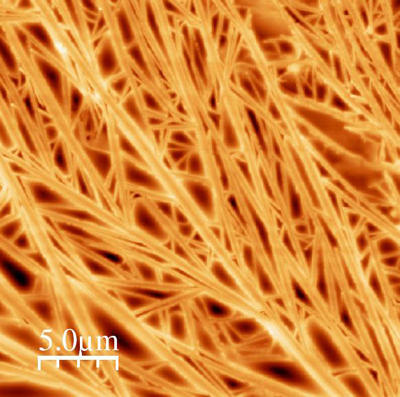Abstract
Apical extracellular matrices (aECMs) are complex extracellular compartments that form important interfaces between animals and their environment. In the adult C. elegans cuticle, layers are connected by regularly spaced columnar structures known as struts. Defects in struts result in swelling of the fluid-filled medial cuticle layer (‘blistering’, Bli). Here we show that three cuticle collagens BLI-1, BLI-2, and BLI-6, play key roles in struts. BLI-1 and BLI-2 are essential for strut formation whereas activating mutations in BLI-6 disrupt strut formation. BLI-1, BLI-2, and BLI-6 precisely colocalize to arrays of puncta in the adult cuticle, corresponding to struts, initially deposited in diffuse stripes adjacent to cuticle furrows. They eventually exhibit tube-like morphology, with the basal ends of BLI-containing struts contact regularly spaced holes in the cuticle. Genetic interaction studies indicate that BLI strut patterning involves interactions with other cuticle components. Our results reveal strut formation as a tractable example of precise aECM patterning at the nanoscale.
Introduction
Apical extracellular matrix (aECM) is found throughout the animal kingdom and forms a variety of structures that play key roles in mediating interactions between organisms and their environment. Well-studied examples of aECM include the collagenous cuticle of nematodes, the chitinous cuticles of arthropods, and sensory structures such as the tectorial membrane of the vertebrate inner ear1. Compared to highly conserved basal ECM structures such as basement membranes2,3,4, aECMs are more diverse in structure, function, and molecular composition. Many aECMs display complex three-dimensional architecture and are intricately patterned at the micro and nano scales5,6. In certain cases aECM patterning has been directly related to cytoskeletal pattern in the underlying epithelium7,8. However in general we understand very little about how complex patterns are generated in aECM.
The cuticle of the nematode C. elegans is a classic example of an aECM that has long been studied for its function in body and skin morphology9,10. The cuticle also plays a critical role in permeability barrier function11, host-pathogen interactions12, auditory sensation13, and sensation of stress or physical damage14. C. elegans generates distinct cuticles in each larval stage; the mature adult cuticle is generated in the final (L4) larval stage15. The cuticle is composed of collagens and a wide variety of non-collagenous proteins16. Cuticle collagens themselves form a large multigene family with approximately 178 members in C. elegans; the functions of about 15% of cuticle collagens have so far been defined by genetic analysis17. Molecular and transcriptomic studies indicate that collagen expression is precisely regulated during each larval stage and in adulthood18,19,20, presumably related to the stage and region-specific 3D architecture of the aECM. Studies of specific collagens have revealed they localize to specific substructures within the cuticle, such as furrows and annuli21. How specific collagens are patterned within the aECM to generate its intricate architecture remains elusive.
The C. elegans adult cuticle is the most structurally complex cuticle type (https://www.wormatlas.org/hermaphrodite/cuticle/Cutframeset.html) and is generated in the mid to late L4 stage. The dorsolateral and ventrolateral adult cuticle, generated by the hyp7 syncytium, contains circumferential ridges (annuli) separated by furrows. The lateral adult cuticle, generated by underlying seam cells, contains lateral longitudinal ridges known as alae8. Unlike larval cuticles, the adult cuticle also contains a fluid-filled medial layer between its outer (cortical) and inner (basal) layers, within which are ordered columnar structures known as struts16,22. Struts likely provide mechanically strong yet flexible attachments between cortical and basal layers of the adult cuticle. Loss of function in struts causes separation of cuticle layers and expansion of the fluid-filled medial layer, the Blistered (Bli) phenotype23. Genetic screens for cuticle morphology defects have yielded six bli genes divided into two molecular classes: three cuticle collagens encoded by bli-1, bli-2, and bli-6 (this study), and three cuticle processing enzymes encoded by bli-3, bli-4, and bli-524,25,26,27.
Here we focus on the function, localization, and interactions of the cuticle collagens encoded by bli-1, bli-2, and bli-6. We define the null phenotypes of these BLI collagens and explore their interactions with each other and with other cuticle components. Using knock-ins to endogenous loci we show that all three BLI proteins are initially expressed in the L4 stage and become localized to cuticle struts in the nascent adult cuticle. We examine the biogenesis of strut puncta and how their patterning depends on other cuticular collagens. Using 3D-structured illumination super-resolution microscopy (3D-SIM) we find evidence for nanoscale organization of struts, revealing previously unknown levels of patterning in the cuticle. Our findings provide insight into how complex pattern is generated in an apical extracellular matrix.
Results
Mutations in three BLI cuticle collagens cause adult-onset blistering
The blistering (Bli) phenotype denotes the appearance of fluid-filled swellings within the cuticle known as blisters (Fig. 1a). As detailed below, mutations in collagens bli-1, bli-2, and bli-6 cause adult-specific Bli phenotypes ranging from mild to severe. Mild blistering is defined as small blisters on the nose and/or tail, or one medium-sized blister in the body; intermediate is defined as several medium-sized blisters, and severe blistering is defined as large blisters extending along the entire body, leading to defects in egg laying, locomotion, feeding, and premature death (Fig. 1a; Tables 1–3). In the most severe bli-1 or bli-2 mutants small blisters are first visible within 3 h of the L4/adult molt and subsequently combine to form larger blisters, leading to severe blistering by ~9 h after the L4/adult molt, with 100% penetrance (n > 50). Severely blistered animals are fertile and typically lay a small number of eggs prior to death. Reduction in bli-1 function via RNAi induces epidermal responses to injury such as upregulation of the antimicrobial peptide nlp-29;28 we confirmed this nlp-29 upregulation in young adults using bli-1 and bli-2 mutants (Fig. 1b). Thus loss of function in the BLI collagens results in adult-onset defects in cuticle integrity and consequent epidermal damage responses.







